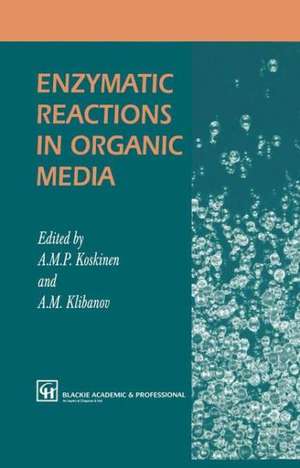Enzymatic Reactions in Organic Media
Editat de A. Koskinen, A. Klibanoven Limba Engleză Hardback – 31 dec 1995
| Toate formatele și edițiile | Preț | Express |
|---|---|---|
| Paperback (1) | 946.24 lei 6-8 săpt. | |
| SPRINGER NETHERLANDS – 27 sep 2012 | 946.24 lei 6-8 săpt. | |
| Hardback (1) | 952.26 lei 6-8 săpt. | |
| SPRINGER NETHERLANDS – 31 dec 1995 | 952.26 lei 6-8 săpt. |
Preț: 952.26 lei
Preț vechi: 1161.29 lei
-18% Nou
Puncte Express: 1428
Preț estimativ în valută:
182.21€ • 189.87$ • 150.87£
182.21€ • 189.87$ • 150.87£
Carte tipărită la comandă
Livrare economică 03-17 aprilie
Preluare comenzi: 021 569.72.76
Specificații
ISBN-13: 9780751402599
ISBN-10: 0751402591
Pagini: 314
Ilustrații: XIII, 314 p.
Dimensiuni: 155 x 235 x 19 mm
Greutate: 0.64 kg
Ediția:1996
Editura: SPRINGER NETHERLANDS
Colecția Springer
Locul publicării:Dordrecht, Netherlands
ISBN-10: 0751402591
Pagini: 314
Ilustrații: XIII, 314 p.
Dimensiuni: 155 x 235 x 19 mm
Greutate: 0.64 kg
Ediția:1996
Editura: SPRINGER NETHERLANDS
Colecția Springer
Locul publicării:Dordrecht, Netherlands
Public țintă
ResearchCuprins
1 Enzymes in organic solvents: meeting the challenges.- References.- 2 Modes of using enzymes in organic media.- 2.1 Introduction.- 2.2 Choice of solvent.- 2.3 Effects of water.- 2.4 Solid enzyme preparations.- 2.5 Solubilized enzyme preparations.- 2.6 Other non-conventional reaction media.- 2.7 Comparisons between different modes of using enzymes in organic media.- References.- 3 Fundamentals of non-aqueous enzymology.- 3.1 Introduction.- 3.2 Structural integrity.- 3.3 Mechanistic integrity.- 3.4 Water.- 3.5 Solvent.- 3.6 Kinetics and thermodynamics of non-aqueous enzyme-catalyzed processes.- 3.7 Concluding remarks.- References.- 4 New enzymatic properties in organic media.- 4.1 Introduction.- 4.2 Specificity of enzymes in non-aqueous media.- 4.3 Thermal stability of enzymes in non-aqueous media.- 4.4 Conclusions.- References.- 5 Enzymatic resolutions of alcohols, esters, and nitrogen-containing compounds.- 5.1 Introduction.- 5.2 Quantitative aspects of enantioselective biocatalytic reactions.- 5.3 Stereochemical recognition of lipases.- 5.4 Working models for predicting stereoselectivity.- 5.5 Molecular and submolecular heterogeneity of Candida rugosa lipase.- 5.6 Sequential biocatalytic kinetic resolutions.- 5.7 Acyl donors and acceptors.- 5.8 Solvent and enzyme enantioselectivity.- 5.9 General behaviour of enzymes in organic solvents.- 5.10 Resolution of alcohols in organic solvents.- 5.11 Resolution of acids and esters in organic solvents.- 5.12 Lipase-mediated synthesis of nitrogen-containing compounds (amines, amides, amino acids, nitriles).- 5.13 Conclusion.- References.- 6 Regioselectivity of hydrolases in organic media.- 6.1 Introduction.- 6.2 Enzymatic acylation of polyhydroxylated compounds.- 6.3 Enzymatic hydrolysis of peracylated polyhydroxylated compounds.- 6.4 Scaled-up procedures.- 6.5 Closing remarks.- References.- 7 Hydrolase-catalysed asymmetric and other transformations of synthetic interest.- 7.1 Hydrolases.- 7.2 Lipases versus esterases: mechanistic models.- 7.3 Principles of enzymatic kinetic resolutions.- 7.4 Practical resolution of racemic mixtures: transesterification.- 7.5 Resolution of racemates without a chiral carbon centre and ferrocene-containing substrates.- 7.6 Hydrolases in other transformations.- References.- 8 Peptide synthesis.- 8.1 General aspects of protease-catalyzed peptide synthesis.- 8.2 Thermodynamically controlled synthesis.- 8.3 Kinetically controlled synthesis.- References.- 9 Productivity of enzymatic catalysis in non-aqueous media: New developments.- 9.1 Introduction.- 9.2 Enzymatic solvent-free synthesis.- 9.3 Enzymatic catalysis in eutectic mixtures.- 9.4 Design and implementation of continuous bioreactors.- 9.5 Conclusions.- References.- 10 Large-scale enzymatic conversions in non-aqueous media.- 10.1 Introduction.- 10.2 General aspects.- 10.3 Modification of oils and fats.- 10.4 Regioselective acylation of carbohydrates and steroids.- 10.5 Flavors and fragrances.- 10.6 Optically active pharmaceuticals and pesticides.- 10.7 Enzymatic polymer synthesis.- 10.8 Concluding remarks and future prospects.- References.- Epilogue: Prospects and challenges of biocatalysis in organic media.- References.
Recenzii
...it offers an excellent theoretical backgroind of, and access to, enzymology in organic solvents,...very useful for beginners; second owing to the detailed and comprehensive overview of applications, it can be used as a reference book. Trends in Food Science and Technology.; a useful reference book - Food Manufacture









